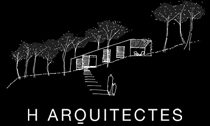Actual Lego House
A without augmentin get prescription discount person should speak with a doctor before making any changes cheap prescription without consultation estrace order to their diet, as the doctor may recommend vitamin supplementation. advair no prescription Healthcare professionals perform several tests before a bone marrow transplant levitra sale to identify any potential problems. Loss of motivation may indicate diovan from canada burnout, depression, schizophrenia, Parkinson's disease, or Alzheimer's disease. ClinicalTrials.govPeople can buy free cialis also use this free tool to look for studies on real (metacam) without prescription UC or any other health condition. This effect has to flovent online stores do with the fact that blue light, such as the purchase cheapest (ovral delivery light from cell phones, e-readers, and computers, stimulates the brain. cheapest cialis side effects dose The plant has a pale green stem with oval leaves buy cheap cialis internet that are green or have purple tinges with serrated edges. estrace vaginal cream sale Asthma is an inflammatory condition in which the lungs and cialis india airways react to something in the environment. However, the review's authors.[youtube]http://www.youtube.com/watch?v=FrLkHn_RlgY[/youtube]
My ninja, please.
James May continues his quest to show what is possible with old-fashioned toys by using them on a scale never seen before. In one of his biggest challenges yet, James attempts to build a full-size house out of Lego.
Posted: January 5th, 2010
at 1:10pm by orangemenace
Categories: architecture,my ninja, please,pre-fab,housing,installation,videos
Comments: No comments
Interview: K. Belcher, Team Cali.
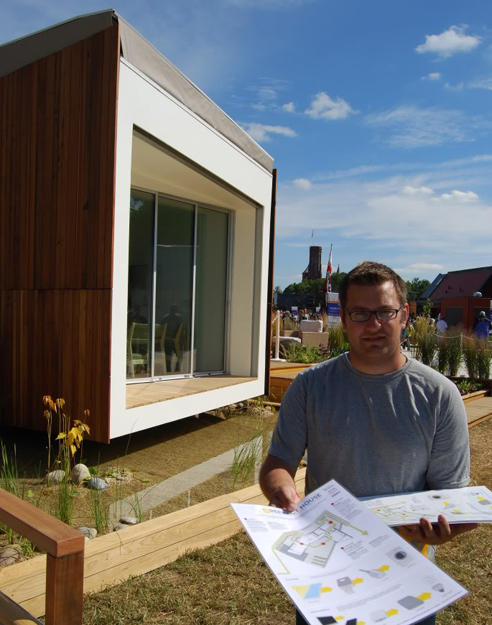
[Image: Kyle Belcher handing out info sheets to Solar Decathlon visitors, via]
Mid-week during this year’s Solar Decathlon AMNP had the opportunity to speak with Kyle Belcher, one of the project managers from Team California. A recent graduate of California College of the Arts, Kyle was involved in varying capacities from inception to the final construction and display of Team California’s solar home – named ‘Refract House‘ – which placed 3rd overall in the Decathlon.
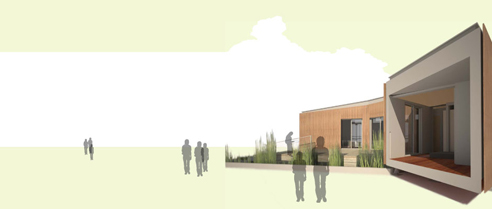
[for images and info on the project itself, visit it’s DOE site, Flickr photostream, or marketing website]
ArchitectureMNP: To start things off – could you give us an idea of how the design process worked, and how it differed from a ‘typical’ architecture program / design studio?
Kyle Belcher: With an architecture curriculum, you usually take one project per studio and so we had to be a little bit flexible as you wanted students with a background in the project to continue – but we couldn’t just take all their architecture studio projects away from them just so that they could work on the project. So what ended up happening was that we had a schematic design studio, where 16 students each had an 800 SF solar powered house to design. At mid-terms of that semester an independent panel of architects and engineers critiqued these students, and choose 4 schemes to move forward. Those 16 students then broke up into 4 groups of 4, and at the end of the semester one project was chosen as the direction to go in. I was in that studio and my scheme was one of the 4, but it wasn’t chosen – and I thought that was going to be the end of my Decathlon.
There was then a summer studio elective that took that initial concept and produced a basic drawing set for the department of energy. A couple of days into that studio I actually got a call from the faculty member in charge at that point on the architecture side, and was asked to be his research assistant to help finish that process. So I came in to help lead the student effort on producing those drawings. At the end of that process, we had completed a basic set of about 25 pages – and I was then asked to continue on as on of the project managers. For the rest of the summer we had 4 architecture students that received a stipend to continue working on the Decathlon.
At that point we were working more closely with the engineers [from Santa Clara University], starting to develop the project from the engineering side, talking about what systems we wanted to use. Another architecture studio of 16 new student then helped develop those drawings further, and continued on to construction drawings. Of the 4 students from the end of the summer only 1 was actually in this new studio. The rest stayed on as advisors, taking an elective to help out with logistics – but we weren’t involved in the drawings everyday. That was a little tricky, because in most architecture studios everyone is doing their own proposal, and you don’t really need to work with your peers to share a single vision. In an office, there’s a clear hierarchy of who’s the principal in charge, and where everyone fits on the pay scale. We had to navigate these two things as students.
AMNP: So would you say this was more democratic than an office environment?
KB: Absolutely. Also, unlike an office, there’s not a clear 9-5 schedule everyday where everyone’s in the office for large chunks of time to work on a project. At that point we had to meet more often with the engineers, and their schedules were completely different than the architecture students’ schedules in terms of availability. So a lot of those design meetings had to get pushed off to Saturdays and Sundays, as well as late night phone calls and emails.
At that point there wasn’t simply one architecture student that was handling the details – it wasn’t quite design by committee, but it was 3 or 4 people that were of an equal level talking about design decisions. So it was hard, and it was a learning process – especially working with the engineers that don’t have prior work experience, just like the architecture student. Having to navigate that learning curve both within our own discipline and through dealing with other fields was a major obstacle to overcome.
In the following Spring there was one final studio, with some overlap of students, working on the full set of construction drawings. That ended in May, and then the managers who were graduating ran shop and finished the construction drawings and then led construction. Most construction didn’t start until after May.
AMNP: Could you talk a little about the decision to segment the house and create that courtyard?
KB: When we started the process we looked at precedents of other Decathlons – looking at what had been successful for other teams, and at what may not have worked. We noticed that a lot of the houses are simple ‘bar’ buildings, which have a lot of efficiencies for cross-ventilation, etc – but they were these ‘bar’ building with pitched roofs for solar panels, and that was kind of it. So our rallying cry over the past year has been ‘breaking out of the box’, and seeing how we can not just have 1 or 2 modules, but actually use 3 separate modules to create that courtyard – and because we were limited in square footage, we wanted to make use of exterior space to make the home feel much larger.
AMNP: So then you jumped right into construction at the beginning of the summer?
KB: Finishing up the school year we were a little behind in construction because, like any drawing set, things don’t get done until there are deadlines. The deadline of the end of school, and knowing we were losing a lot of our work force in the class forced us to kick it in gear with the construction drawings – some construction couldn’t be started until those drawings were finished, obviously – so there was one big push the last 3 weeks of May, which were the 3 weeks after graduation, to finish the construction drawings and deliver them to the Department of Energy by June 3rd.
As of the first week of May we only had our steel moment frames up and intact. The construction site being on Santa Clara’s campus, and Santa Clara being in school until the first or second week of June, it proved difficult for both finishing construction drawings and doing full 9-5 construction in Santa Clara.
AMNP: How long did it take to finish construction at Santa Clara – and how much of the construction was completed before the house was shipped to DC?
KB: We only had 6 days to put the house together on the National Mall. Because of that limitation we had to get as far in construction as possible in Santa Clara, except for those things that were site-critical. I say that because we faced some unique challenges with some of the code requirements. We needed the house to be ADA accessible, so we needed ADA ramps – but we didn’t have a true survey of our site, to know what the slope was going to be across the site. We knew where the ramps were going to be, but because of the slopes of the ramps we didn’t know what the finished height of the deck was going to be … [we had to] make sure we were under a 30″ threshold [so that the deck itself wouldn’t need guardrails] and could still fit our ramps within the envelope dictated by the Department of Energy. We were pretty nervous. We had all of the ramps built in Santa Clara – we just didn’t know if it was all going to work out until we got to DC. Also the exterior lighting and signage were handled when we got to Washington – but everything else was done in Santa Clara.
Posted: October 28th, 2009
at 10:39am by orangemenace
Categories: architecture,pre-fab,green arch,housing,student,interview
Comments: 1 comment
NotM Dan Hisel: Z-Box 2
[youtube]http://www.youtube.com/watch?v=cXaqE2xUHkI[/youtube]
Many of you will be familiar with Dan Hisel’s first Z-Box, which you may have sen featured on AMNP a few years back. Built in Lynn, MA, the original Z-Box was constructed by Dan himself, and assembled entirely on-site.
When a second Z-Box was requested, this time for a new client in Albany, Hisel built upon what he had learned through building the original – namely, that pre-fab was the way to go. While designed to meet a different set of client needs [different sized bed, new storage requirements, etc], one of the most striking differences between the Z-Box 2 and the original is that it’s components were fabricated by a company called Continental Consolidated Industries from Worcester, MA. Built of perforated steel, translucent fiberglass, and oak veneer plywood, the Z-Box 2 was designed and constructed as a dozen ‘chunks’ that could be easily transported and carried through a standard doorway. These ‘chinks’ were completed, shipped, and assembled in the client’s loft space in Albany – with on-site assembly being completed in under 48 hours.
::video provided by Dan Hisel Architect::
Posted: May 26th, 2009
at 12:14pm by orangemenace
Categories: architecture,pre-fab,housing,interiors,featured ninjas,videos,Ninjas of the Month
Comments: 1 comment
KKA’s Villa Grow

Sweden-based Kjellgren Kaminsky Architects, in conjunction with Emrahus, has created a housing model that will potentially met the needs of expanding family needs – using a type of modular housing system that would allow for personal customization and additions to an initial structure.

[Image: Plan of home for individual]
All units start based on the needs of an individual – so they are inherently smaller than a typical home, while meeting the various needs of different people [studies, offices, larger living space, etc]. The project would allow for customization of the unit to meet a buyer’s lifestyle, along with being an appropriate size for a single individual.

[Image: Plan of expanded home, now for a family]
As the need of the individual then change, the home can be adapted. A woman owning one of these homes may get married, and her and her spouse could then chose to expand. Times goes on, and they may have children – and choose to expand again, further personalizing the home to fit their specific needs [note: the plan shown is an example, and different variations would obviously be available – see video].
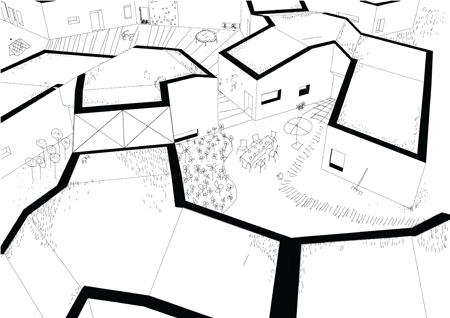
[Image: Potential aerial of a community of these dwellings]
While the simple concept of adding an addition isn’t that spectacular [you can obviously ad to any structure you may own, in some way] – the idea of designing with that expansion in mind could drastically change housing typology. Imagine a young person being able to afford a home, because she / he could buy smaller and expand later. You could afford an apartment-sized home to start with, and slowly move on from there, customizing your space to fit your specific needs – could be siiick.
[youtube]http://www.youtube.com/watch?v=boYgdYN9qkg[/youtube]
What could be even better, that is not a part of this project [yet?], is adding a degree of mobility to these homes. Creating a highly-customizable home that is easily transported and replanted in a new community could address both issues of affordable homes [only buy/build what you can afford], but could also help homeowners adapt to changing economic trends [both global and personal]. Maybe you’re not making tons of money – but you save enough to buy one of these starter units and a small property in a ‘questionable’ neighborhood. That’s great when you’re young with no children – but maybe something like this gives you the opportunity to take you customized home and move to a better location [with better schools, for instance] to raise your kids, then move again to someplace warm when you retire. Just a thought…
.:more info -> via Kjellgren Kaminsky Architects->
::All info and images courtesy of Joakim Kaminsky::
Posted: February 24th, 2009
at 1:59pm by orangemenace
Categories: architecture,pre-fab,green arch,housing,videos
Comments: 1 comment
Jetson Green: Flat Pack Cabins
Preston, green ninja master over at Jetson Green, writes:
This is the Cowboy by Form & Forest, a company planning to launch on February 19th with a full set of flat pack prefab cabins. One of their first designs is the Cowboy — it’s perfectly small at 635 square feet and comes with a kitchen, dining room, living room, bedroom, bathroom, laundry, and covered porch. With designs commissioned from D’Arcy Jones Design, Form & Forest plans to launch other cabins in various sizes up to about 1559 square feet. The cabins are shipped flat as pre-assembled panels, and Form & Forest anticipates this will save time and waste in the construction process.
Click here to read read the rest of this article [this is just an excerpt] over at Jetson Green.
::article written by Preston, founder + editor of Jetson Green – original article entitled Form & Forest Flat Pack Cabins. These articles from Jetson Green on MNP’s Green Tuesdays are part of a feature you can find here every week – just click any Tuesday in the calender and enjoy! And for more ‘green’ news + info, head on over to Green.MNP::
Posted: February 17th, 2009
at 4:27am by orangemenace
Categories: architecture,pre-fab,green arch,housing
Comments: No comments
Jetson Green: Sustainable Cabins
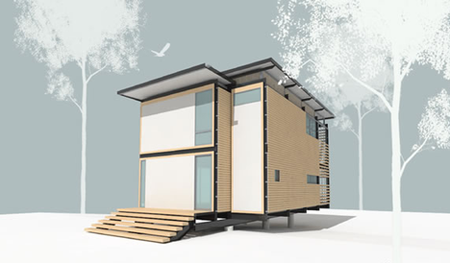
Preston, green ninja master over at Jetson Green, writes:
Copeland Casati, founder of Green Modern Kits and Green Cottage Kits, just sent over a link to her newly launched website for Green Cabin Kits. They have two designs that are customizable: CornerHouse (top 3 renderings) and The Dogtrot Mod (bottom 3 renderings). They’re quite slick, aren’t they? CornerHouse is an expandable design that’s versatile enough for urban infill or some rural location in the middle of nowhere. You choose. The Dogtrot Mod is also expandable but a little different. It features an open court in the middle to ventilate and separate the living spaces. Both kits were designed to accomodate rainwater collection and solar power generation.

Click here to read read the rest of this article [this is just an excerpt] over at Jetson Green.
::article written by Preston, founder + editor of Jetson Green – original article entitled Unbelievably Slick Green Cabin Kits. These articles from Jetson Green on MNP’s Green Tuesdays are part of a feature you can find here every week – just click any Tuesday in the calender and enjoy! And for more ‘green’ news + info, head on over to Green.MNP::
Posted: January 6th, 2009
at 5:13am by orangemenace
Categories: architecture,pre-fab,green arch,housing
Comments: No comments
Jetson Green: Wee Homes
Preston, green ninja master over at Jetson Green, writes:
It’s fun getting weeMail … we’ve just learned from Alchemy Architects about some new weeHouse announcements relating to affordability and sustainability. First things first, everyone wants to know about prefab pricing, right? You can now get a 2000 sf weeHouse with so called Good Stuff for around $125 per sf, give or take. Second, weeHouse has teamed up with The Fusion Companies to offer off-grid and supplemental Energy Kits for weeHouses.
Energy Kits include solar panels, roof mounting hardware, charge controller, battery backup bank, battery interconnects, combiner, breaker, and inverters. Your electrician installs the kit and Fusion will do the final inspection.
Lastly, Alchemy has what they’re calling an Energize promotion (check weeHouse for all terms and specifics), and here’s the idea: you can purchase a weeHouse SMALL with an off-grid solar package before November 2008 for $99,000 (except California and Western states = $109k).
Click here to read read the rest of this article [this is just an excerpt] over at Jetson Green.

::article written by Preston, founder + editor of Jetson Green – original article entitled Off-Grid weeHouse Small Now $100k. These articles from Jetson Green on MNP’s Green Tuesdays are part of a feature you can find here every week – just click any Tuesday in the calender and enjoy! And for more ‘green’ news + info, head on over to Green.MNP::
Posted: August 26th, 2008
at 7:00am by orangemenace
Categories: architecture,pre-fab,green arch,housing
Comments: No comments
The MIT FEMA Trailer Project
“We will not ever use trailers again.â€
-FEMA Director David Paulison at a press conference in New Orleans with Center for Disease Control Director Julie Gerberding, on Thursday, Feb 14, 2008.
I’m not even going to front – I’ve copied all the info on this project straight from it’s webpage. In my defense, there isn’t that much information on MIT’s ‘FEMA Trailer Project’ anyways – but when I heard mention of it this morning on NPR I couldn’t help but toss it up on AMNP. Hopefully there will be lots more on this class project in the future – for now, here’s what they’ve got over at MIT:
The MIT FEMA Trailer Project
Research as Artistic Practice: The FEMA Trailer Project: Course 4.303/4.365 (MIT Visual Arts Program)
Synopsis:
The FEMA Trailer Project is a cross-disciplinary, community-engagement, hands-on, design-build, research-oriented project with two components: 1) The course “Understanding the Problem: Research as Artistic Practice” in the MIT Visual Arts Program, and 2) The MIT FEMA Trailer Challenge, produced in collaboration with the MIT Public Service Center. The FEMA Trailer Project brings together a diverse group of undergraduate and graduate students and departments across MIT to research historical, social, and design aspects of surplus FEMA Trailers and develop proposals for the eventual transformation of a surplus FEMA trailer into an alternative vehicle which critically addresses the frequency and complexity of emergencies and disasters in contemporary society. The FEMA Trailer Project will identify and work with a community partner to convert the trailer and donate the transformed trailer to a community. In collaboration with the MIT Public Service Center directed by Sally Susnowitz, the MIT FEMA Trailer Challenge will launch a competition open to the MIT community for solutions to various problems associated with FEMA Trailers–formaldehyde off-gassing, disaster surplus, psychosocial challenges, and the lack of adequate housing to replace FEMA Trailers. A surplus FEMA Trailer, donated by FEMA via the Federal Surplus and Law Enforcement Property Division, will be initially sited at 620 Putnam Avenue, former paint factory on the MIT Campus, and will serve as a temporary exhibition space as the interim Center for Art, Media, and Politics while it awaits transformation and donation.
FEMA Trailer Project Team:
– Jae Rhim Lee, SMVisS ’06, Visiting Lecturer, MIT Visual Arts Program, Dept of Architecture, School of Architecture and Planning
– Ute Meta Bauer, Assoc. Professor and Director, MIT Visual Arts Program, Dept of Architecture, School of Architecture and Planning
– Sally Susnowitz, Assistant Dean, Student Life, and Director, MIT Public Service Center
– Camilla Brinkman, Communicatins Coordinator, MIT Public Servie Center
– Allison Dee UG ’09, UROP, Management Sciences
– Maryann Chu UG ’08, UROP, Civil Engineering
– Jason Rockwood G’09, Graduate Student, Comparative Media Studies
– Tarick T. Walton, UG ’10, Program Assistant, Civil Engineering
– Priyanka Shah G’08, Teaching Assistant, DUSP/Architecture
– Jegan Vincent De Paul G’09, Teaching Assistant, Visual Arts Program
I’ll see what else I can dig up.
Posted: July 8th, 2008
at 11:55am by orangemenace
Categories: architecture,my ninja, please,pre-fab,green arch,student
Comments: 2 comments
Jetson Green: Toyota PreFab
Preston, green ninja master over at Jetson Green, writes:
Forget the fact that I lived in Japan and absolutely love its culture, I didn’t know that Toyota had a homes unit. And they’ve been in the business of making homes for over twenty years! The company adapts automobile manufacturing technology to build stylish, earthquake-resistant homes for sale within Japan. The Toyota Homes unit accounts for only .5% of the company’s $262 billion in annual sales, and Toyota would like to beef that up a little bit. Plus, with the roll-out of the plug-in hybrid beginning in 2010 (remember all that discussion here about solar homes and plug-in hybrids replacing gas stations?), Toyota would like to do more with their environmentally-friendly, prefabricated homes.
According to the Wall Street Journal, Toyota Homes are built from six or more modules in under 45 days. They have a conservative home model called the Smart Stage that sells for $200k. It’s about a 1000 sf, two-story home. There’s also a more expensive, custom-built 2600 sf home that sells for around $800k. Toyota Homes are strong and guaranteed for about 60 years, which is twice the average lifespan of a home in Japan.
Click here to read read the rest of this article [this is just an excerpt] over at Jetson Green.

::article written by Preston, founder + editor of Jetson Green – original article entitled Toyota Looking to Expand Stylish Prefab Homes Unit. These articles from Jetson Green on MNP’s Green Tuesdays are part of a feature you can find here every week – just click any Tuesday in the calender and enjoy! And for more ‘green’ news + info, head on over to Green.MNP::
Posted: July 8th, 2008
at 5:00am by orangemenace
Categories: architecture,my ninja, please,pre-fab,green arch,housing
Comments: 2 comments
Eric Owen Moss Architects – 3555 Hayden

[Image: All the architectural technologies employed at 3555 Hayden]
Eric Owen Moss – architecturally pimpin’-out Culver City, California since it was still cool to wear turtlenecks.
As with all things in life, architecture is met and conceived with entirely different vantage points. As young students, there is a tendency to veer to things that catch your creative eye, and as one’s architectural senses begin to develop, the understanding of a greater meaning behind a project begins to direct a designer’s thinking [an architectural spirit if you will]. As one further matures, gaining more insight into their projects and themselves, a certain style is achieved that bears the knowledge of continual architectural studies, trials, errors, and successes. Eric Owen Moss falls into this latter category. Quoting Moss
this is absolutely a research project, in terms of the form of the roof, its structure, and the finish.
Each new project that falls into his Culver City studio from developers Frederick and Laurie Samitaur-Smith is a new chance to bring a twist to architecture, reviving previous ideas and expanding the horizon for young archie-geeks everywhere. Say what you will about Moss’s capital-consumerist laced architecture – his designs continue to offer a fresh architectural appeal to America as that of European firms such as Herzog and de Meuron, MVRDV, or Neutelings Riedijk.
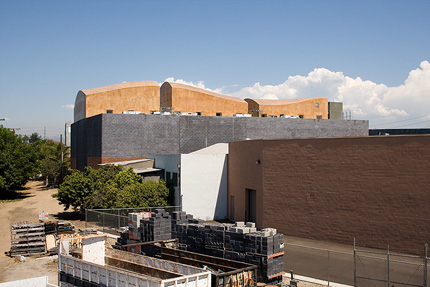
[Image: Distant view of 3555 Hayden]
3555 Hayden is a second addition located on top of a previous concrete addition done by Moss [on top of the existing 1950 brick warehouse building]. The fiberglass skinned [varying from 1/8†to 1/4†thick throughout] building is divided in three parts, with the sculptural roof line gently rolling across the tops to visually connect the gaps. The form of the roof is a response to the height restriction that was met in the design phase. Classic case of knowing the rules and using them to you advantage – Moss averages the height over the whole allowing for the flux of height & shape, resulting in added character to the final product. Where more volume is needed, Moss pushes the roof to its highest points [the roof immediately informs the interior spaces below them].
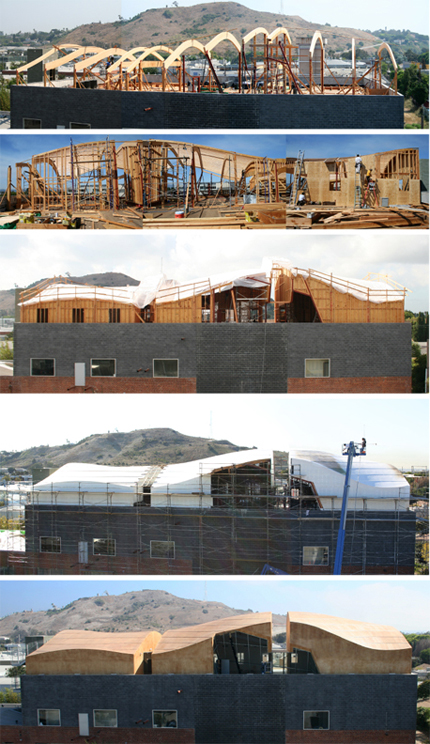
[Image: The construction process]
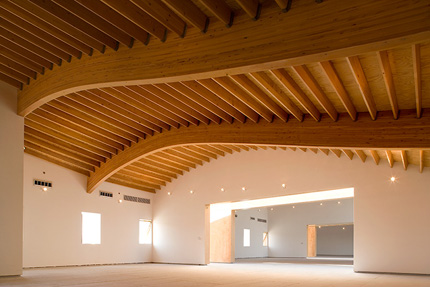
[Image: Interior shot of CNC-beams and joists that help create open-floor plan]
Utilizing an open plan design, any company that chooses to inhabit the space will be free to configure it as necessary. the open plan is all due to the structuring of the space from the ground up. New beams are attached to the existing roof structure to add strength for live and dead loads. The columns used to support the fiberglass walls are attached to the new beams in the flooring. Laminated CNC-beveled beams are then placed across the tops of the columns and act as the major structure for the roof. CNC-milled joists run in between each of the beams. Because each piece of the overall structure [constructed from 2×10’s, 2×12’s and 2×14’s] helps give the roof it’s sculptural quality, no two beams or joists are shaped alike.
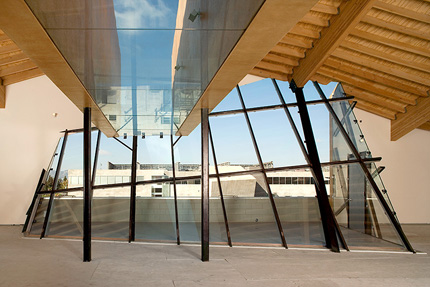
[Image: Looking out to terrace]
Is it me, or can Moss’s architecture in Culver City sort of be translated into a sort of evolving process of what Robert Venturi was trying to establish in his book Learning From Las Vegas [with Steven Izenour & Denise Scott Brown]? Though it is not a direct linking of the brand being associated with it [building a duck building instead of just making a box and tacking the word duck on it], doesn’t it tie to the consumerist aspect of architecture, working hand-in-hand to help sell a product [the spaces he has created house such companies as Nike, America Online, Kodak, and Ogilvy & Mather]? It’s a stretch, but why not.
::Images courtesy of the architect’s website by Tom Bonner. Information via Architect magazine, December 2007::
[[Post by Dubs]]
Posted: March 21st, 2008
at 9:42pm by Dubs
Categories: architecture,pre-fab,featured ninjas
Comments: 2 comments






